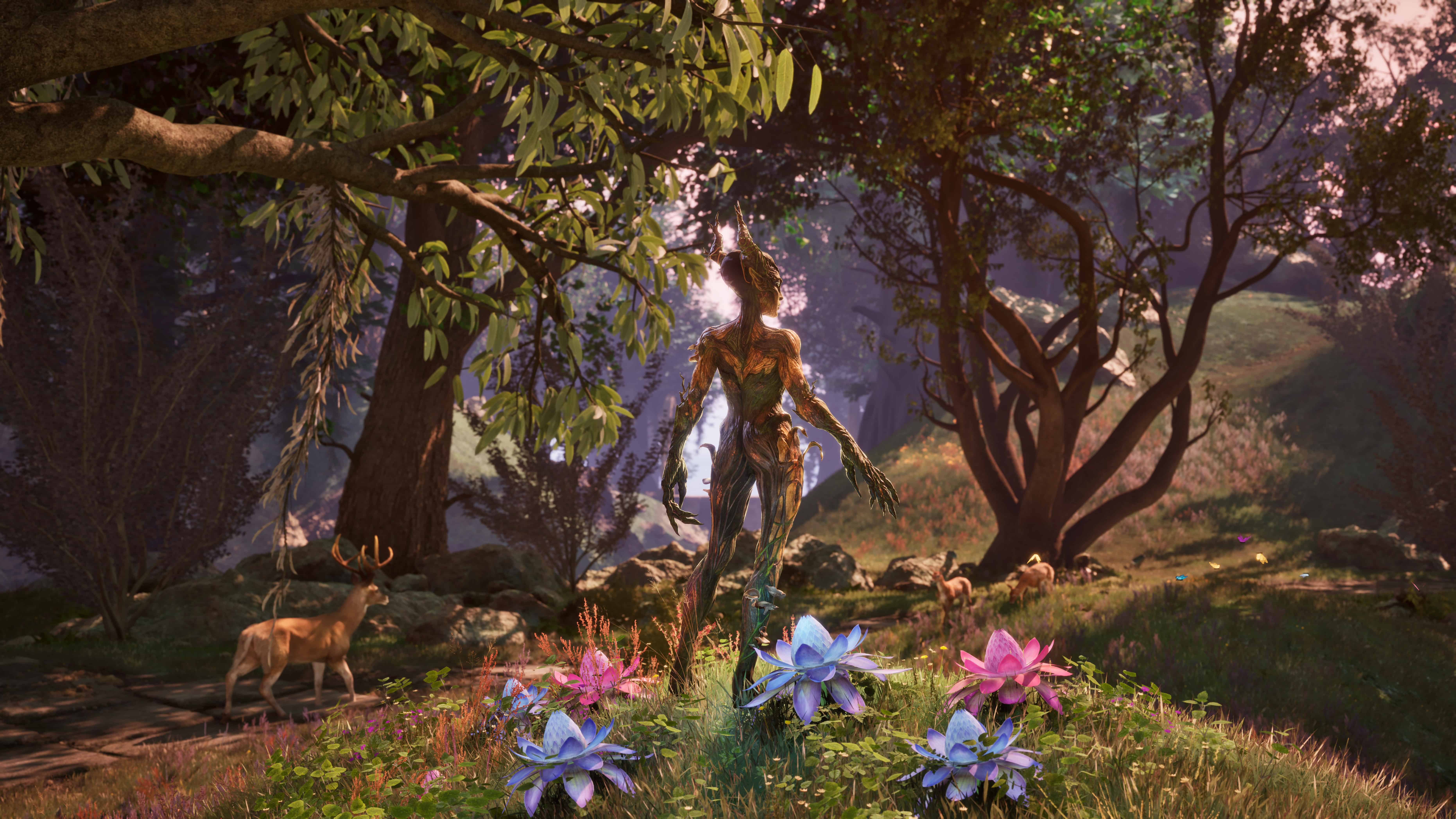The gentle hum of arcane energies, the golden fields of Cyrodiil stretching beyond sight, and the unmistakable swell of Jeremy Soule’s score—The Elder Scrolls IV: Oblivion once shaped the very definition of an open-world RPG. Now, nearly two decades later, Bethesda and Virtuos have revived this legendary adventure with The Elder Scrolls IV: Oblivion Remastered, which dropped unexpectedly on April 22, 2025. After logging significant time in this updated world, it’s clear: this remaster offers a deeply nostalgic journey with modern edges—though not without some turbulence.
Visual Overhaul: Unreal Engine 5 Breathes New Life into Cyrodiil

From the moment you step outside the Imperial Sewers, Oblivion Remastered immediately dazzles. Built on Unreal Engine 5, the improvements aren’t just cosmetic—they’re transformative. Cyrodiil’s once-flat landscapes are now rich with volumetric fog, realistic lighting, and detailed textures. Lumen’s dynamic global illumination means that shafts of light pierce through dense forest canopies, while dungeons are bathed in ominous, flickering torchlight that reacts naturally to movement. Water physics have also received an upgrade, with ripples and reflections that make lakes and rivers feel more authentic than ever.
Character models, often a punchline in the original, have been reworked. Faces still maintain their distinctive charm (and yes, the occasional awkwardness), but improved animation rigs and better material textures give a far greater sense of realism. Armor and weapons glint believably under sunlight, and the Oblivion Gates now ooze an even more terrifying presence thanks to richer particle effects and refined demonic designs.
Gameplay Refinements: Classic Feel, Sharper Execution
At its core, Oblivion Remastered retains the systems that made the 2006 original so enduring—but smart updates help bridge the gap to modern expectations. Sprinting is now a default feature, removing one of the original’s slowest pain points. Combat has received a noticeable lift: new attack and dodge animations bring a welcome fluidity to battles, though the slightly clunky hit detection and physics quirks from the old engine occasionally peek through.
The leveling system, once famously easy to exploit, has been lightly rebalanced, borrowing subtle elements from Skyrim without abandoning Oblivion’s distinct flavor. Sneaking, archery, and spellcasting all feel a touch more responsive. In a world where RPG combat has evolved dramatically, Oblivion Remastered strikes a careful balance between preserving its old-school soul and smoothing the roughest edges.
The UI overhaul deserves praise too. Menus are cleaner and more navigable, fonts are easier to read, and the quest journal is now segmented in a way that makes side quests and main objectives more intuitive to track. Improved lip-syncing, especially during key dialogue sequences, makes conversations feel far less robotic than in the original release.
The World of Cyrodiil: Bigger, Brighter, and More Alive
Exploration has always been at the heart of Oblivion, and the remaster enhances it tremendously. Draw distances are significantly longer, populating hills with distant forts, farms, and city skylines that beckon players to explore. Weather effects—rolling thunderstorms, dense morning fogs, and snowy gusts—add new layers of atmosphere to the game’s many biomes.
The included expansions, Knights of the Nine and Shivering Isles, are seamlessly integrated into the base experience. The Shivering Isles in particular benefits massively from the remaster, its surreal dreamscape textures and psychedelic colors now vibrantly enhanced in a way that finally matches the madness of Sheogorath’s realm.
Technical Woes: A Rougher Start Than Expected
Unfortunately, the launch wasn’t without problems. PC players reported widespread issues, including frame drops, hitching, and stuttering—even on high-end systems. Digital Foundry’s performance analysis called the initial PC release “dire,” citing optimization flaws that dampened the experience for many. A day-one patch (1.9GB) tried to address some issues but introduced a frustrating bug that broke DLSS support, forcing players to rely on native resolutions or alternative upscaling methods.
Console players fared slightly better: the Xbox Series X version received a hotfix that stabilized some of the worst areas, though minor hiccups persist, particularly during heavy battle sequences and dense cityscapes. The PlayStation 5 version emerged as the most stable, running mostly smoothly at a dynamic 4K resolution with minimal dips, though it’s not entirely free of small frame pacing issues.

Bethesda and Virtuos have been quick to issue patches, but the early technical instability remains a blemish on what could otherwise be considered a triumphant return.
Nostalgia Meets Opportunity: Community and Modding
Even in its current state, Oblivion Remastered reminds players why the original remains so beloved. Whether you’re stealthily assassinating targets for the Dark Brotherhood, hunting artifacts for the Mages Guild, or simply wandering off the beaten path to find hidden shrines and forgotten ruins, Cyrodiil’s magic endures.
Encouragingly, the PC modding community has already begun adapting old mods and creating new ones tailored for the remaster. Bethesda has confirmed that the Skyblivion fan project, which aims to remake Oblivion within the Skyrim engine, will continue unaffected, giving players the best of both worlds in the near future.
The infamous Horse Armor DLC, once the poster child for questionable microtransactions, also makes a tongue-in-cheek return as part of the Deluxe Edition—this time bundled with new exclusive armor sets and cosmetics, playfully embracing its legacy rather than shying from it.
Early Verdict: A Promising Yet Imperfect Renaissance
The Elder Scrolls IV: Oblivion Remastered succeeds at something tricky: it rekindles the wonder of 2006 while making enough modernizations to stand alongside contemporary RPGs. It’s not flawless—the technical problems at launch, particularly for PC users, are significant hurdles that Bethesda must urgently address. But the heart and soul of Oblivion shine through brightly.
For longtime fans, this remaster feels like coming home to a place that both looks and feels like you always remembered it. For newcomers, it offers a sprawling, imaginative RPG experience that, even in 2025, feels unique compared to today’s more streamlined offerings.
If Virtuos and Bethesda can continue to polish performance and perhaps even add future enhancements based on community feedback, Oblivion Remastered could easily become the definitive way to experience Cyrodiil’s magic for years to come.
Personal First Impressions: The Good, The Bad, and The Nostalgic
Playing Oblivion Remastered feels like reconnecting with an old friend—you instantly remember why you loved them, but you also can’t ignore the quirks you forgot about. The updated visuals hit me right in the nostalgia. Walking into the Imperial City for the first time again, with the new lighting pouring down through the towering White-Gold Tower, actually gave me goosebumps. It’s how I thought it looked back in 2006, even though deep down I know the original was a lot rougher.
That said, there’s no denying this is still very much Oblivion at its core, for better and for worse. The combat improvements help, but the occasional jank still peeks through. You’re swinging swords and flinging spells with more polish now, but don’t expect a complete overhaul that feels like Skyrim or Elden Ring. It’s smoother, not re-invented.
Performance issues? Oh yeah, they’re real. On my mid-range PC, the game dipped like crazy in crowded areas and had some annoying stuttering during outdoor exploration. The first patch fixed some things but broke DLSS for me, which was a pretty brutal tradeoff. On Series X, it’s better, but you’ll still notice frame hitches when the world gets too busy. It’s frustrating because the updated world deserves a flawless technical execution, and it’s just not there yet.
Still, even with the rough spots, I couldn’t stop playing. Joining the Thieves Guild again, getting lost in side quests I forgot existed, running from town guards because I picked a flower I wasn’t supposed to—it all felt timeless. Bethesda and Virtuos clearly tried to respect what made Oblivion special, and in a lot of ways, they nailed it.
If you’re a veteran of Cyrodiil, you’ll find a lot to love here once you adjust to the modernized (but still slightly crusty) package. If you’re new, there’s a bit of a learning curve—you can feel the 2006 design roots—but stick with it, and you’ll discover one of the most charming, sprawling RPGs ever made.
Is it perfect? Not even close. Is it worth playing? Absolutely.
Especially if you miss when open-world games weren’t afraid to be a little weird, a little messy, and totally magical.
Key Takeaways
- Graphics see major updates, while the original style is kept.
- Gameplay stays faithful to what made Oblivion popular.
- Some audio and character issues from the classic version remain.
Graphics and Visual Improvements
Oblivion Remastered updates the entire visual presentation with better graphics, advanced lighting, and new character models. Bethesda and Virtuos have used new design tools to make Tamriel more vivid and easier to navigate.
Visual Overhaul and Lighting Effects
Oblivion Remastered uses the Unreal Engine 5 for stronger graphics. The world features higher-resolution textures and sharper details. Trees, rocks, and buildings now have more distinct shapes and surfaces. Colors have more depth and landscapes look less blurry, especially at long distances.
Dynamic lighting is a key change. Sunlight now moves across the land, casting more realistic shadows. Torches and spells create soft, shifting glows in caves and dungeons. Water reflects skies and nearby objects in real time, making rivers and lakes appear more alive.
Table: Key Visual Updates
| Feature | Original | Remastered |
|---|---|---|
| Textures | Low-res | High-res (4K ready) |
| Lighting | Static | Dynamic + ray-traced |
| Shadows | Basic | Soft + natural |
| Reflections | Minimal | Real-time, accurate |
Some fans note that the sharper graphics highlight aging design in areas, but most find the upgrade noticeable and immersive.
Character Models and Animations
Character models now have more polygons, so faces look less flat and expressions look more natural. Clothing folds and armor details stand out. Hair and beards look thicker and move slightly with the character’s motion.
Animations for movement and combat are smoother. Characters turn and swing weapons in a more lifelike way. Spellcasting uses new hand motions, and non-player characters (NPCs) react with subtle gestures instead of stiff, old poses.
Combat also gets a small refresh. Hits connect more accurately, and blocking feels heavier. Players can spot “hit” and “miss” events better because of these cleaner, new animations.
User Interface and Accessibility Features
The remaster introduces a clearer user interface. Menus open and close faster. Icons for health, magic, and stamina have clean edges and better contrast. Bethesda and Virtuos made the inventory sortable, making it easier to manage items, weapons, and potions.
The crosshair is smaller and sharper, which helps with aiming. Tooltips now give extra information without crowding the screen.
Accessibility improvements include:
- Larger fonts for dialogue and journal
- Color-blind friendly UI options
- More frequent autosaves for less progress loss
Players can remap most controls, allowing more people to enjoy the game in a way that works best for them. Many of these changes make long sessions feel less tiring and navigation much smoother.
Gameplay and Content Enhancements
Oblivion Remastered aims to balance respect for the original game with upgrades that matter most to players. Visual improvements and gameplay tweaks help the 2006 classic feel updated for modern systems.
Updated Gameplay Mechanics
The remaster builds on core gameplay by improving controls and updating combat. Movement is smoother, and animations feel tighter than in the original release. Players notice more responsive input, especially in melee and magic.
Character creation has received new options. More faces, hairstyles, and minor tweaks make it easier to design a unique hero. The leveling system gets adjustments so that gains feel less punishing and allow more freedom in playstyle.
Enemy scaling is less aggressive compared to the original. This makes exploring feel more rewarding, especially as players progress. Combat improvements are subtle but keep fights interesting and less repetitive.
The game targets a steady 60 frames per second on PC, PS5, and Xbox Series X/S. This makes movement and battles smoother than before. Menus and inventory have small quality-of-life upgrades, cutting down on time spent managing gear.
Reimagined World of Cyrodiil
Tamriel’s province of Cyrodiil receives a new visual overhaul. Environments show better lighting, improved textures, and detailed landscapes, bringing forests, cities, and dungeons up to modern standards. The draw distance is longer, reducing the original’s “pop-in” issues.
NPCs now use updated models and improved animations. New lines of voice dialogue appear in side quests, making the world feel more alive. Towns and cities have busier streets, with more background activity visible in markets and inns.
Soundtrack changes are subtle but clear. Some music is remastered, offering higher quality, while classic tracks remain untouched for nostalgia. Interiors and exteriors now have more ambient sounds, making Cyrodiil sound richer and more immersive.
Loading times are much shorter on all platforms. Moving between zones or fast-traveling feels seamless, removing an old source of frustration.
DLC and Additional Content
Oblivion Remastered includes all previous DLC content, such as Shivering Isles and Knights of the Nine. These expansions work from the start, so players don’t need to buy or install anything extra.
Shivering Isles brings a new area full of unique enemies and quests. Knights of the Nine gives access to special artifacts and storylines. Minor add-ons like new houses and equipment packs are also available in the core experience.
Extra dialogue has been added to some DLC quests, helping characters feel less flat. Bug fixes address older problems like quest-breaking glitches or missing rewards. DLC areas show the same lighting and graphical upgrades as the main game.
All content can be accessed on PC, PS5, and Xbox Series X/S. This helps make the complete version easy to enjoy without switching devices.
Platforms and Modding Support
Oblivion Remastered is available on PC through Steam and the Microsoft Store, as well as on PS5 and Xbox Series X/S. Players with Game Pass or Game Pass Ultimate get access at no extra cost.
PC gets the deepest modding options. Support for mods is built around the game’s new codebase, and the community expects updates for popular mods and new tools like OBSE (Oblivion Script Extender). Steam Workshop integration is helpful for installing mods with one click.
Console players see fewer mod options, but select community add-ons and expansions may become available. Cross-save is supported within platform families, like between Xbox One and Series X/S.
Table: Platforms and Modding
| Platform | Modding Support | Features |
|---|---|---|
| PC (Steam, MS) | Full | Mods, 60 fps, Workshop, OBSE-ready |
| PS5 | Limited | 60 fps, all DLC, fast load times |
| Xbox Series X/S | Moderate | 60 fps, Game Pass, some modding |
Overall, the remaster supports both newcomers and longtime fans with a focus on performance, content, and player choice.
Frequently Asked Questions
Oblivion Remastered features modern graphics and updated enemy designs. The package also includes special edition contents and has seen feedback from critics and players.
What are the improvements in the remastered version of Oblivion compared to the original?
The remaster uses enhanced textures and models, improving lighting and character detail. Enemy visuals have also been updated. These changes make the world look sharper and more detailed on new hardware.
How has the remaster affected Oblivion’s gameplay and mechanics?
General gameplay remains true to the original. Controls, combat, and quest design have not seen major overhauls. Quality-of-life tweaks may be present, but the core systems behave much as before.
Can you detail the exclusive contents of Oblivion Remastered Deluxe edition?
The Deluxe edition often includes bonus digital art, a soundtrack, and in-game items or cosmetic packs. Specifics can depend on the region and platform. These extras are not essential for gameplay but offer more content for fans.
Are there any significant differences between the console and PC versions of Oblivion Remastered?
Differences are usually minor and relate to performance options, controls, and graphics settings. PC players can adjust resolution and settings more deeply. Both versions have the same main content.
What has been the general critical reception to Oblivion Remastered according to review aggregators like Metacritic?
Reviews are mostly positive. Critics and players say the remaster improves visuals while keeping the original experience. Some feedback mentions that the mechanics still feel dated.
Have there been any notable patches or updates to Oblivion Remastered post-launch?
Post-launch updates have addressed technical bugs and performance. Patches improve stability and fix graphical glitches. No major new features have been added through these updates.







